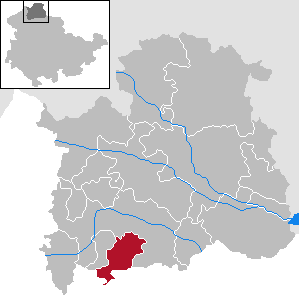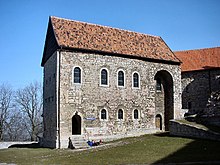Großlohra
| coat of arms | Germany map | |
|---|---|---|

|
Coordinates: 51 ° 25 ' N , 10 ° 39' E |
|
| Basic data | ||
| State : | Thuringia | |
| County : | Nordhausen | |
| Fulfilling municipality : | Bleicherode | |
| Height : | 310 m above sea level NHN | |
| Area : | 18.45 km 2 | |
| Residents: | 907 (Dec. 31, 2019) | |
| Population density : | 49 inhabitants per km 2 | |
| Postal code : | 99759 | |
| Area code : | 036338 | |
| License plate : | NDH | |
| Community key : | 16 0 62 009 | |
| Address of the municipal administration: |
Kirchberg 41 OT Großiegen 99759 Großlohra |
|
| Mayor : | Siegfried Schäfer | |
| Location of the community Großlohra in the district of Nordhausen | ||
Großlohra is a municipality in the Nordhausen district in Thuringia . It is located on the northern edge of the Hainleite , about 2 km from the former federal highway 80 and the federal highway 38 and about 20 km from the district town of Nordhausen . Sights are the Lohra Castle with its Romanesque double chapel and the Romanesque basilica of St. Gangolf in Munich- Lohra .
geography
Großlohra lies on the northern edge of the western foothills of the Hainleite ridge . Lohra Castle itself is located on a mountain ledge at a height of around 300–400 m. To the north, the Hainleite drops quickly in the direction of the Wippertal, so that, in good weather, you have a wide view from the castle over the southern Harz to the Brocken .
Neighboring communities are (clockwise) Bleicherode , Sondershausen , Helbedündorf and Niedergebra .
structure
Großlohra consists of the four districts:
- Friedrichslohra
- Large turns
- Small turns
- Munchenlohra
- today's Teichmühle farm in the far east of the municipality
history
Fortified structures probably existed on the site of today's Lohra Castle as early as Germanic times. The current facility was built by the Counts of Lare (Lohra) in the 11th / 12th. Century expanded into the largest castle in the southwestern Vorharz. Until the 16th century it was owned by the Count families of Lohra, Beichlingen , Klettenberg and Hohnstein, among others . At the latest during the Thirty Years' War , in which the castle was conquered and badly damaged several times, it lost its importance. After the Peace of Westphalia , it fell to Prussia and was used as an agricultural property as the Lohra office until 1977. This domain had 385 hectares in 1923. Gerd Peters was the tenant of the estate.
The places Großwend and Kleinwend arose during the Middle Ages as presumably "Wendish" (i.e. Slavic) settlements, Münchenlohra as an estate around the former monastery church. The place Friedrichslohra was only founded in the 18th century through a settlement project by the Prussian King Friedrich II . Farmers and weavers, mainly from Eichsfeld , were settled in the area around the Lohra district. The street in which the first 22 houses were built is still called 22-er Straße today . During the 18th and 19th centuries, the Prussian state carried out projects for the settlement of Sinti in Friedrichslohra , among other things in the form of an "education home", which existed from 1831 to 1837. It is the present day kindergarten building.
Since the beginning of the era of National Socialism 1933, the Sinti were discriminated enhanced polices and since 1939 in the "Gypsy camp" quarry in Krimderode interned and forced labor used. Seven of them were murdered in the Auschwitz concentration camp .
On July 1, 1950, the community of Großlohra was created through the merger of the previously independent communities of Friedrichslohra, Großwend and Kleinwend. From 1991 to the end of 2018 it was a member of the Hainleite administrative community . After its dissolution, Bleicherode is a fulfilling community for Großlohra.
politics
Municipal council
The municipal council in Großlohra consists of eight council members:
- CDU 3 seats
- UB 5 seats
(Status: Local elections in Thuringia 2019 )
coat of arms
Description : "In the red shield covered with four golden linden leaves is a silver, gold-crowned lion, holding a golden pedum in the front paws."
Culture and sights
The Castle Lohra is to be recognized as on a mountain spur located resort already from several kilometers away. It is the largest castle in the western southern Harz. The Romanesque double chapel with an original separation between the upper floor and the lower floor is remarkable. The theory of separation for reasons of origin (upper floor for rule and lower floor for common people) is controversial today. Double chapels were certainly also built for reasons of space. The second attraction is the Romanesque basilica of St. Gangolf in Münchenlohra, which was built around 1170 as a monastery church of a Benedictine monastery. After the Reformation, the other monastery buildings fell into disrepair. Only the basilica remained and was reconstructed in the 19th century. Hosts regular evening church services held and occasionally concerts.
Personalities
- Heinrich Ludwig Smalian (1785–1848), head forester in Stralsund and inventor of tree measuring instruments.
literature
- Michael Stampniok: The St. Gangolf nunnery in Munich-Lohra . In: Meyenburg Museum (ed.): Contributions to local history from the city and district of Nordhausen . Issue 19. Nordhausen 1994, p. 56-62 .
- Siegel, Wolfram: The holy Gangolf in Münchenlohra at the Hainleite. Basilica, monastery and Carolingian prehistory , Lukas Vlg f. Art and Intellectual History, 2005
- Kuhlbrodt, Peter: Lohra, Hainleite: a journey of discovery through 2000 years of local history , 1987
Web links
Individual evidence
- ^ Population of the municipalities from the Thuringian State Office for Statistics ( help on this ).
- ↑ Jürgen Gruhle: Black Book of Land Reform, Internet, 2011
- ↑ Barbara Danckwortt, Franz Mettbach - The consequences of the Prussian "Gypsy policy" for the Sinti in Friedrichslohra. In: Danckwortt, Barbara; Querg, Thorsten; Schöningh, Claudia (ed.): Historical research on racism. Ideologies - perpetrators - victims. Hamburg; Berlin 1995, pp. 273-295.
- ↑ The Gypsies in Friedrichslohra . Eisenbergisches Nachrichtensblatt, December 2, 1833. Retrieved January 26, 2010.
- ↑ Friedrichslohra . In: Heinrich August Pierer , Julius Löbe (Hrsg.): Universal Lexicon of the Present and the Past . 4th edition. tape 19 . Altenburg 1865, p. 845 ( zeno.org ).
- ↑ Thuringian Association of the Persecuted of the Nazi Regime - Association of Antifascists and Study Group of German Resistance 1933–1945 (Ed.): Heimatgeschichtlicher Wegweiser to places of resistance and persecution 1933–1945, series: Heimatgeschichtliche Wegweiser Volume 8 Thüringen, Erfurt 2003, p. 186 , ISBN 3-88864-343-0
- ↑ Municipal council election 2019 in Thuringia - final result of the municipality of Großlohra




